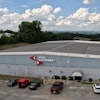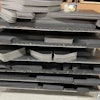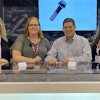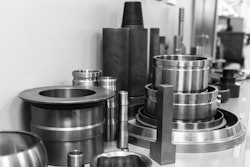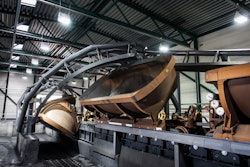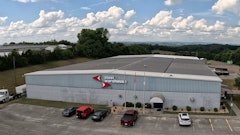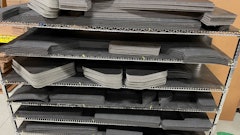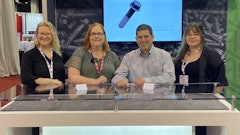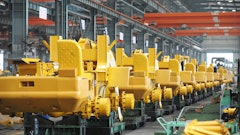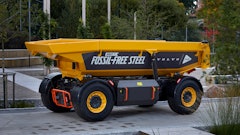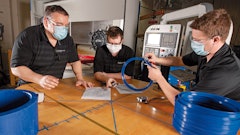
The Internet of Things & Connectivity
How do you see the Internet of Things shaping the direction of the heavy-duty vehicle markets?
As a purveyor of composite materials the IoT might not necessarily seem like a logical extension for advancement but at Polygon we believe that is not the case. Composite materials offer true embeddability options that are just now being explored and developed. The ability to harvest and manipulate data to enhance equipment productivity is extremely compelling and yet to be fully embraced. We have a vision that includes IoT and are investing significant resources toward several application initiatives.
How is your company integrating IoT solutions into your workspace, or what is your perceived plan for implementation and the benefits you foresee with its implementation?
We are uniquely situated in that composites can serve as a platform or enabler to integrate IoT directly into existing structural components or systems. This is a concept we call embeddability where such things as sensors, circuitry and logic can be placed entirely within the laminate structure of composite materials. This represents a more robust, functional and less invasive solutions approach. An example of this is that we worked with the South Dakota School of Mines on integrated bridge tendons. The project yielded a composite tendon which could sense the load being carried by the bridge via sensors embedded directly within the structure of the composite tendon.
How has this concept influenced how you approach technology development and new ideas?
Providing the opportunity to fully integrate secondary elements within the structure of our materials is extremely compelling. Getting the industry to conceptualize the potential embedded composites offer is difficult because implementation takes considerable collaboration between materials engineering and numerous electronic interfaces. These engineering disciplines typically do not coexist within most manufacturing entities.
The Future of Diesel
There are several opinions on the future of the diesel engine market. With large metropolitan cities like Paris and Madrid announcing diesel bans by 2040, it seems there is a presupposed end to diesel reliance. Where do you see diesel playing a role in heavy-duty applications in the long-run?
We serve a number of European customers and are aware of these proposed regulations. A clear path forward remains a rather strategic conundrum. If history serves as a guide, we would expect to see some type of hybridized system(s) advance forward that would not eliminate diesel but rather play to the strengths a hybrid system would offer.
Any expectation for significant shifts in diesel engine technology or expectations in the near-term?
Today we don’t see any significant shifts related to composite structures other than lighter weight materials being more strongly considered which have a direct correlation to productive energy verses energy consumed to initialize the equipment or vehicle – weight that translates into productive energy verses static weight simply because of the structural requirements.
Managing the Data Trend
How is your company utilizing data in new and valuable ways?
We are trying to integrate systems with some of our key customers to see if we can leverage and expand engineering application knowledge. In many of our larger multi-national clients we witness duplication efforts where similar projects are underway missing synergy. This wastes engineering time and resources. We are mutually trying to create platforms where we disseminate application knowledge so that our customers can be first to market.
What value is this providing to your company and customers?
Offering a methodology where engineering teams, within the same corporation, can see what similar projects are going on at any given geographic location.
Where do you see data leading the industry? What is its potential?
If properly maintained and guarded it can provide a significant barrier to entry against competition. If not properly protected anyone anywhere in the world can gain significant traction at a very low technological investment point.
Several manufacturers are now investing in data analyst and programmer experts to shape the direction of their company and its use of data. What is your company’s end goal with data?
Composite are again unique in that as an industry we are emerging from an art form to that of being more empirical. Some of that resides within the anisotropic nature of our materials. Collecting, analyzing and deciphering data will be critical for these materials to advance and escalate forward capturing market share from more traditional material solutions. Metallic data bases have been around for centuries so we face some significant engineering challenges when trying to demonstrate capability.
Challenges & Opportunities
What new challenges have arisen that effect the way you design or manufacture your product? How you do business? How you go to market? How you differentiate yourself from the competition?
From the inception of the composites industry our challenge has been that of educating the engineering community of the advantages of incorporating composites into their designs. The engineering community is rooted in what we refer to as a “Metals Mentality.” We view our competition as metallic rather than actual composite manufacturing entities. Our focus has been to market and present ourselves as the best alternative to traditional metallic designs. We try and position ourselves next to or near metallic counterparts to capture engineering mind share when looking for solutions. We also believe in pushing the envelope with respect to being creative.
Has the rate of technological advancement (for example, the rapid emergence of data products) had any impact on business decisions, development, or product performance and client expectations?
While the “Metals Mentality” is diminishing, another obstacle is convincing our markets that composites can provide the appropriate value. Significant data exists relative to high-performance carbon-based composites which translates into high-cost solutions. Most of this resides within the significant contributions the aerospace and military have brought forward but it somewhat taints the viability for composites in OEM industrial applications. This adds additional work for us to overcome.
What is your company’s opportunity to impact the marketplace with a unique product, capability or offering?
Universally composites have so much upside potential. OEM industrial applications have been a bit more difficult to broach. The concept of sensor embeddability to facilitate IoT, high strength coupled with light weight provides the opportunity to better utilize energy into work (productivity) using less inertia, while secondary things such as corrosion resistance and increased damage tolerance all portent well for the OEM industrial markets.
The Global Landscape
Has the recent nationalism focus for several key countries including the U.S. altered the way you evaluate international opportunities, work with global partners, or any part of your business currently? Do you see an impact in the future?
We’ve recently repositioned our China facility to that of licensee rather than being directly owned. Chinese costs are escalating and significant uncertainty exists with respect to trade so we felt the transition timing was right. We are also hesitating on making some strategic investments in Mexico because of these same uncertainties. For an entity of our size the risks are significant. My overarching fear is that North American markets are so positive at the moment that we will make short term decisions predicated where we are today rather than where we might be headed long term. We constantly discuss the possibility of considerable future headwinds because of our national debt. The challenge is keeping the vision perspective out 5-7 years.
What are your regions/markets of interest for expansion or investment you are looking at for future opportunities?
We are advancing more energy and effort into South America while keeping an eye on the potential in Africa for the next decade. We see anything related to fluid power and motion control as being exciting and filled with opportunity.
Are there any new industries or applications you are exploring?
Recent studies have favorably predicted the growth potential for composite materials. We are so opportunity rich that the problems reside more in ascertaining which one to seize upon and how best to execute.
What key policies are you watching closely that could impact your business, either positively or negatively?
It seems as if we are universally at a point of no return as nation. Several years ago, I asked our team to read James Piereson’s “Shattered Consensus” because it appeared to be very predictive of where we are today. Universally in the US we can’t seem to reach any consensus which significantly contributes to confusion within industry. This leads to compromised decision making as well as spending considerable time and effort on alternative “what if’s."
